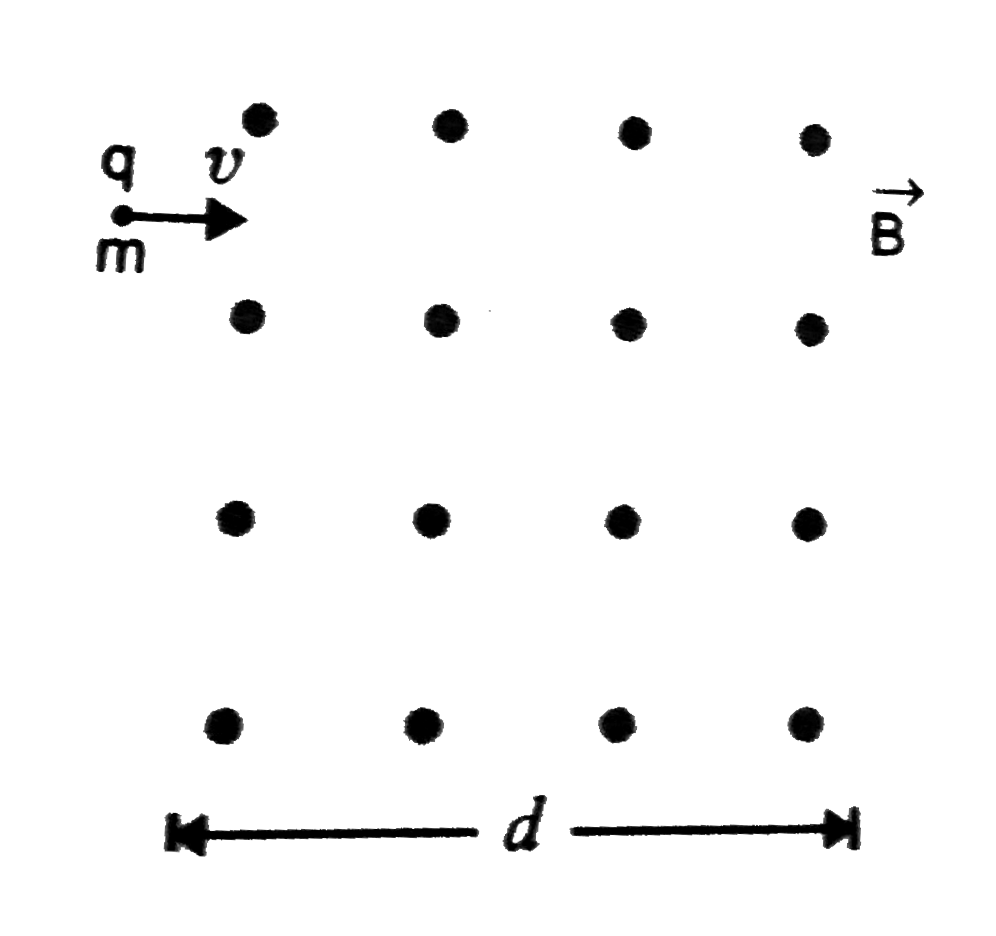A particle with a specific charge s is fired with a speed v toward a wall at a distance d, perpendicular to the wall. What minimum magnetic field must exist in this region for the particle not to hit the wall?
v/sd
2v/sd
v/2sd
v/4sd
The correct Answer is:a
To solve the problem, we need to determine the minimum magnetic field required for a charged particle to move in a circular path without hitting the wall. Here’s a step-by-step solution:
Step 1: Understand the motion of the particle
When a charged particle moves in a magnetic field, it experiences a magnetic force that causes it to move in a circular path. The radius of this circular path is determined by the balance between the magnetic force and the centripetal force required to keep the particle in circular motion.
Hint: Recall the relationship between magnetic force, centripetal force, and radius in circular motion.
Step 2: Write down the equations for forces
The magnetic force FB acting on the particle is given by:
FB=qvB
where:
- q is the charge of the particle,
- v is the speed of the particle,
- B is the magnetic field strength.
The centripetal force FC required to keep the particle moving in a circular path is given by:
FC=mv2r
where:
- m is the mass of the particle,
- r is the radius of the circular path.
Hint: Set the magnetic force equal to the centripetal force for circular motion.
Step 3: Set the forces equal to each other
For the particle to not hit the wall, the magnetic force must equal the centripetal force:
qvB=mv2r
Hint: Rearrange the equation to solve for the magnetic field B.
Step 4: Solve for the magnetic field B
Rearranging the equation gives:
B=mvqr
Step 5: Relate the radius to the distance to the wall
In this scenario, the distance d to the wall is equal to the radius r of the circular path. Therefore, we can substitute r with d:
B=mvqd
Step 6: Substitute the specific charge
The specific charge s is defined as:
s=qm
Thus, we can rewrite the magnetic field equation as:
B=vsd
Final Answer
The minimum magnetic field B that must exist in this region for the particle not to hit the wall is:
B=vsd
When a charged particle moves in a magnetic field, it experiences a magnetic force that causes it to move in a circular path. The radius of this circular path is determined by the balance between the magnetic force and the centripetal force required to keep the particle in circular motion.
The magnetic force FB acting on the particle is given by:
FB=qvB
where:
- q is the charge of the particle,
- v is the speed of the particle,
- B is the magnetic field strength.
FC=mv2r
where:
- m is the mass of the particle,
- r is the radius of the circular path.
For the particle to not hit the wall, the magnetic force must equal the centripetal force:
qvB=mv2r
Rearranging the equation gives:
B=mvqr
In this scenario, the distance d to the wall is equal to the radius r of the circular path. Therefore, we can substitute r with d:
B=mvqd
The specific charge s is defined as:
s=qm
Thus, we can rewrite the magnetic field equation as:
B=vsd
The minimum magnetic field B that must exist in this region for the particle not to hit the wall is:
B=vsd
Topper's Solved these Questions
- BOOK - CENGAGE PHYSICSCHAPTER - MAGNETIC FIELD AND MAGNETIC FORCESEXERCISE - Exercises Multiple Correct25videos
MAGNETIC FIELD AND MAGNETIC FORCES
- BOOK - CENGAGE PHYSICSCHAPTER - MAGNETIC FIELD AND MAGNETIC FORCESEXERCISE - Exercises Assertion -reasoning8videos
MAGNETIC FIELD AND MAGNETIC FORCES
- BOOK - CENGAGE PHYSICSCHAPTER - MAGNETIC FIELD AND MAGNETIC FORCESEXERCISE - Exercises Subjective10videos
MAGNETIC FIELD AND MAGNETIC FORCES
- BOOK - CENGAGE PHYSICSCHAPTER - KINETIC THEORYEXERCISE - Question Bank31videos
KINETIC THEORY
- BOOK - CENGAGE PHYSICSCHAPTER - Magnetism and MatterEXERCISE - Question Bank50videos
Magnetism and Matter
Similar Questions
Knowledge Check
- Question 1 - Select One
If a charged particle enters perpendicular in the uniform magnetic field then
AEnergy remains constant but moment changesBEnergy and momentum both remains constantCMomentum remains constant but energy changesDNeither energy nor momentum remains constant - Question 2 - Select One
A charged particle enters a uniform magnetic field perpendicular to it. The magnetic field
Aincreases the K.E. of the particleBdecreases the K.E. of the particleCchanges the direction of motion of the particleDdoes both (a) and ( c) - Question 3 - Select One
When a charged particle moves perpendicular to a magnetic field, then:
Aspeed of the particles is changedBspeed of the particle remains unchangedCdirection of motion of the particle remains unchangedDacceleration of the particle remains unchanged
A charged particle enters a uniform magnetic field with velocity v0=4m/s perpendicular to it, the length of magnetic field is x=(√32)R, where R is the radius of the circular path of the particle in the field. Find the magnitude of charge in velocity (in m/s) of the particle when it comes out of the field.
View SolutionThe magnetic force on a charged particle is always perpendicular to its velocity. Can the magnetic force change the velocity of the particle?Speed of the particle?
View SolutionWhen a charged particle moves perpendicular to a magnetic field, then:
View SolutionA particle of charge q and mass m, is fired perpenducular to a magnetic field (B) with a velocity v. What is the frequency of revolution of the particle?
View SolutionA charged particle of mass m and charge q is projected into a uniform magnetic field of induciton →B with speed v which is perpendicular to →B. The width of the magnetic field is d. The impulse imparted to the particle by the field is (d<<mv/qB)
 View Solution
View Solution

